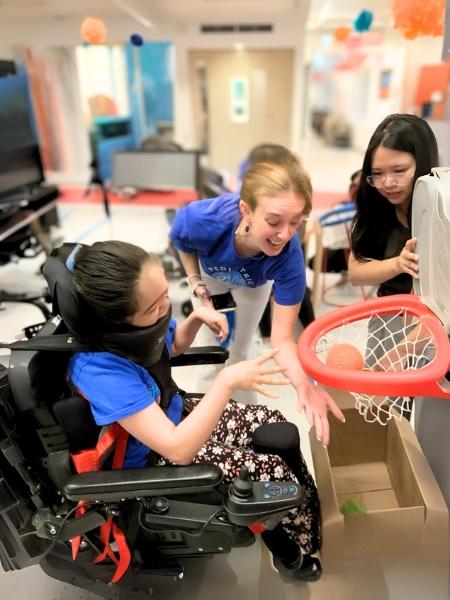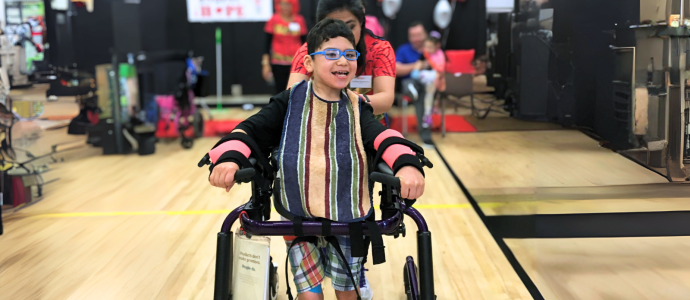Share
When Iskandar Ibragimov enrolled his son, Samandar, at iHOPE nearly a decade ago, he had just one goal: “My only wish was for him to take one step,” he said.
Samandar, affectionately called Sammy, has cerebral palsy and does not use words to communicate. When he first started school, walking even a short distance seemed impossible. But through years of persistence, therapy, and encouragement at the International Academy of Hope (iHOPE), a YAI affiliate school, Samandar not only took that step, but is now crossing finish lines.
This year, the 19-year-old is participating in the 10-foot dash at the school’s annual iHOPE Games, now in its 11th year. It is a three-day celebration of adaptive sports for students with significant physical and cognitive disabilities.
“I remember six years ago, Samandar participated in the 10-foot dash, and he was the first to cross the finish line,” Ibragimov recalled. “That moment was very emotional. To see him achieve something like that, it was truly incredible for me and my wife.”
A study in the Journal of Spinal Cord Medicine found that wheelchair users who participate in adaptive sports have significantly higher cardiorespiratory fitness, helping prevent secondary health issues. Moreover, a national survey by Move United reported that 89% of participants in adaptive sports experienced improved self-esteem and confidence, and 94% felt a stronger sense of community.

Held during the second week of August every year, the iHOPE Games transform the Midtown Manhattan school into a bustling arena of adapted athletic events. This year, students will compete in seven sports: bowling, basketball, the 10-foot dash, obstacle course, soccer, darts, and a class relay race. The Games showcase true teamwork, with related service providers and classroom staff collaborating to adapt each activity to students’ unique needs—creating a joyful, inclusive experience for all. All 150 students, regardless of mobility, strength, or communication needs, are supported to participate and celebrate one another’s milestones.
“We’re not just designing games, we’re helping kids connect to their environment, to their peers, and to understanding their own potential,” said Jesse Simon, an occupational therapist at iHOPE and member of the assistive technology team who plays a key role in modifying the sports activities.
“This motivating experience often carries over into their therapy, how they engage at school overall, and creates moments of joy when they’re smiling, laughing, and truly participating,” he added.
The Games are as individualized as the students. A 10-foot dash might be completed with a gait trainer, walker, wheelchair, or staff support. Likewise, students who are non-ambulatory might compete in bowling by rolling their own bodies across a mat to knock down pins. Each sport is adapted through a tiered system to match students’ abilities.
“Our adaptations make sure students with different levels of mobility, strength, or motor control can still participate meaningfully,” said Simon. “For instance, we often incorporate switch-accessible designs, which allow students to control a game or tool using a switch that can be activated with something as simple as a tap of the finger or a turn of the head.”
Take soccer, for example. If a student can’t kick a ball, iHOPE staff create a tabletop version using plastic boards and overlays. A switch-powered “kicker” hits a small ball toward the goal, similar to foosball.
For the obstacle course event, a blow dryer powered by a switch pushes a ball through a maze. A paraprofessional holds the dryer while the student controls it with their switch, simulating mobility-based games for those who aren't physically participating.
“We put a lot of care into ensuring every student can observe the effect of their actions,” said Simon. “When a student hits their switch and sees a ball move or a buzzer sound, it reinforces that their actions matter. That sense of agency is incredibly empowering for students with disabilities.”
For Samandar, the Games remain a highlight of the year. “Even though he can’t walk long distances anymore, he still participates,” Ibragimov said. “The Games give him a chance to enjoy life and discover what he’s capable of.”
As Samandar prepares to graduate in two years, Ibragimov is already thinking ahead, hoping to keep his son active and socially engaged through sports and community programs. But for now, the family is savoring every medal, every cheer, and every hard-earned victory.
“We could never have imagined how far Samandar would come,” Ibragimov said. “Seeing him make friends and find his community has been our greatest joy.”

